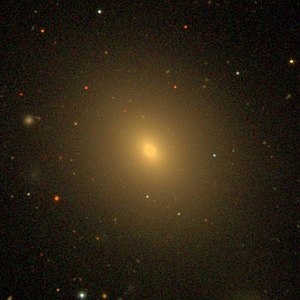NGC 7619
| Galaxy NGC 7619 |
|
|---|---|

|
|
| SDSS recording | |
| AladinLite | |
| Constellation | Pegasus |
|
Position equinox : J2000.0 , epoch : J2000.0 |
|
| Right ascension | 23 h 20 m 14.5 s |
| declination | + 08 ° 12 ′ 22 ″ |
| Appearance | |
| Morphological type | E. |
| Brightness (visual) | 11.1 mag |
| Brightness (B-band) | 12.1 mag |
| Angular expansion | 2.5 ′ × 2.3 ′ |
| Position angle | 30 ° |
| Surface brightness | 13.1 mag / arcmin² |
| Physical data | |
| Affiliation | LGG 473 |
| Redshift | 0.012549 ± 0.000017 |
| Radial velocity | 3762 ± 5 km / s |
|
Stroke distance v rad / H 0 |
(175 ± 12) · 10 6 ly (53.6 ± 3.8) Mpc |
| history | |
| discovery | Wilhelm Herschel |
| Discovery date | September 26, 1785 |
| Catalog names | |
| NGC 7619 • UGC 12523 • PGC 71121 • CGCG 406-073 • MCG + 01-59-52 • 2MASX J23201452 + 0812226 • GC 4936 • H II 439 • h 2230 • | |
NGC 7619 is a Hubble-type elliptical galaxy E1? in the constellation Pegasus in the northern sky , which is an estimated 175 million light years from the Milky Way .
The galaxies NGC 7617 , NGC 7621 , NGC 7623 , NGC 7626 are in the same area of the sky .
The object was discovered by Wilhelm Herschel on September 26, 1785 .
